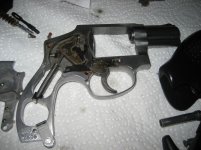chp
Member
I understand why a hammer block is required in a S&W with a hammer mounted firing pin.
Why do you need a hammer block in the current revolvers w/o the hammer mounted firing pin? Thanks for educating me!
Why do you need a hammer block in the current revolvers w/o the hammer mounted firing pin? Thanks for educating me!


